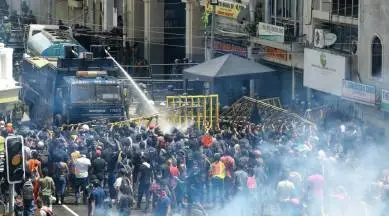Two months ago, I wrote in these columns of how commodity prices had shot up after Russia’s invasion of Ukraine in February, but then receded considerably by mid-May. I said the good news was that inflation had probably peaked, while the bad news was that a recession was causing this.
It is time for an update. The trend broadly remains one of falling commodity prices with one or two exceptions. The most important change is a welcome crash in world food prices. Meanwhile, the riots and fall of the Sri Lanka government constitute a warning that many other governments may fall too across the world. Much political turmoil lies ahead.
Green Parachutes
The Ukraine war severely disrupted world agricultural markets. Ukraine and Russia account for a big chunk of global wheat, maize and sunflower oil exports from Black Sea ports, which have stopped functioning because of the war. Attempts to revive that maritime trade under guarantees have failed. The consequent shortage of wheat has impacted the price of maize, which is a substitute for wheat in human and animal diets. The shortage of sunflower oil has spilled over into shortages and high prices of other edible oils.
This has stoked fears of horrendous hunger and famine in countries heavily dependent on food imports, especially poor African countries. The good news is that food prices have fallen very substantially, so predictions of mass world hunger and starvation have proved terribly exaggerated. A problem remains, but of a vastly smaller dimension than feared in March.
Wheat was just $4.50 a bushel a few years ago, but started rising fast in 2021, well before the Ukraine war. Indian wheat was too high priced to be exported in 2019 and 2020. But India was able to export 7 million tonnes of wheat in 2021-22 when the world price rose to $7 per bushel.
The Ukraine war sent wheat skyrocketing to $14.82 a bushel in April. By mid-May, when I last wrote, the price had moderated only slightly to 12.65 a bushel. But now it has crashed to $8.93 a bushel. Corn has also fallen from a peak of $8 a bushel to $6.25. Soybeans are down from $17.79 a bushel to $15.16.
Wheat is still above its pre-war price, but maize is down to its pre-war price. This should calm earlier fears of apocalypse.
However, the recent riots and overthrow of the Sri Lankan government show that public anger with soaring prices and shortages run deep and will increase as months go by. Many other developing countries will face similar mass protests, arising not just out of rising global prices but balance of payments crises and bad domestic governance for years. The worst-managed governments will default on foreign debt and face political overthrow. Billions of dollars have already flowed out of emerging markets into safe havens, and billions more will flood out as defaults multiply and the recession deepens.
As You Sow, Prices’ll Crash
The future is grim for developing countries. India will suffer, even though it is in far better shape than most other developing countries.
Pessimists will argue that the sowing of the next wheat and sunflower crops in Ukraine has been so badly disrupted that world shortages will continue till late 2023, at least. Maybe so. But the markets have already baked such forecasts into today’s prices.
In May, we saw a major divergence between the price of industrial commodities, which had slumped, and agricultural commodities, which had stayed high. Today, that divergence is gone, and all prices are falling, while some are truly crashing. The most startling change is in cotton, which had shot up from $8 a pound to $16 in May, but has now crashed to just $9.30, not far above its pre-war rate. Metals continue to fall well below their peak. Aluminium is down from a peak of $3,750 to $2,399; zinc from $4,500 to $3,150; copper from $4.80 to $3.52; palladium from $3,000 to $2,168.
Oil has zigzagged a lot. It touched a peak of $128 a barrel in March, fell to just $103 recently, and is now up at $108. JPMorgan Chase predicts a price as high as $375 a barrel by 2023 if Russia retaliates against Nato sanctions by reducing supplies. At the other end of the spectrum, Citibank predicts a crash to just $60 a barrel this year and as little as $45 a barrel in 2023 if a serious recession strikes. It all depends on whether a recession kills demand, or geopolitics kills supply. I personally am a qualified pessimist.
Bottom line: the threat of mass starvation has diminished considerably. But the threat of an emerging market crisis and toppling of governments has risen considerably. Tighten your seat belts.
This article was originally published in The Economic Times on July 12, 2022.


